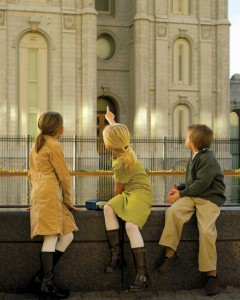Children have an essential place in LDS life. The church believes the home is the center of God’s plan, and parents are responsible for the well-being of their children, including seeing to it they receive both a temporal and a spiritual education. Church programs assist parents, but don’t replace them.
 From birth, LDS children are included in family worship. Families have prayers and scripture study and the children are expected to attend, with their participation increasing as they get older. Even a toddler might lead the music in a family home evening and a kindergarten might conduct the meeting. A third grader may be the official scripture reader for the day. These family activities help children to consider spiritual life a natural part of everyday life, and to teach them how to live a Mormon life.
From birth, LDS children are included in family worship. Families have prayers and scripture study and the children are expected to attend, with their participation increasing as they get older. Even a toddler might lead the music in a family home evening and a kindergarten might conduct the meeting. A third grader may be the official scripture reader for the day. These family activities help children to consider spiritual life a natural part of everyday life, and to teach them how to live a Mormon life.
Children attend the main worship service, called Sacrament Meeting, with their parents. There is no nursery during this time. While it may be a challenge for them to behave for an hour and ten minutes, Mormons are patient with wiggly children who might be a bit noisy and parents are taught to remove their children for a few minutes when they begin to cry or become too loud. From the beginning, sitting in the chapel snuggled with a parent gives a child the sense of church as a place of love and comfort. Gradually, parents begin to remove the book or small toy the child plays with and to help him learn to listen to the speakers. Many parents play quiz games over lunch to help children pay attention and then review the messages given during the service.
After the service, families go in different directions. The children who are
attend a nursery, where several loving adults watch over them. This is not babysitting, however. Although the children do have a play time, they also have simple lessons, songs, and scripture stories that teach them the basics of the gospel. The lesson manual is available online or for purchase, and the parents are encouraged to use it at home as well.
Lesson topics include:
I Love My Family
I Will Share
Heavenly Father and Jesus Christ Love Me
I Can Pray to Heavenly Father
If a child will be four by the end of the year, he begins attending Primary in January. Primary is for children ages 3-12. The youngest children have a lesson manual that is more advanced than the nursery manual, but simpler than those used by older children. This class is known as the Sunbeam class. They are introduced to stories from all the scriptures, with each lesson designed to teach a gospel principle through the story. For instance, they spend many weeks learning about how God created the earth, learning about one small part of the creation each week-water, birds, families, and so on. Through this they are taught respect for the earth and that God loves them and gave them a wonderful place to live.
Children ages four to eight are called CTRs. CTR stands for Choose the Right. Since LDS children are baptized at age 8, they are, at this age, preparing for baptism. This includes learning how to make choices and to understand the consequences of those choices. They are divided into classes based on age. They have a two year curriculum. One year focuses on the Bible and the other on the Book of Mormon and church history. The lesson manuals have suggestions for adapting the lessons to the younger children. When they return to the lesson in a few years, they are older and their teachers tackle the materials at a higher level.
The remaining children use a lesson manual that correspond to the curriculum used by teenagers and adults, but written at their own level. Since the learn the same scripture story as their parents and older siblings on the same week, the family can discuss the stories and principles together at home each week. Their curriculum is a four year curriculum. One year is the Old Testament, and one is the New Testament. The third year is the Book of Mormon, and the fourth is church history and doctrine.
When children turn twelve, they spend part of the Primary time in the teenage program. They join the teens for a youth class, but go to Primary class with the younger children. One night each week, they join the teenagers for an activity night. This allows them a gentle transition into the more grown-up program of the teens and pre-teens.
Children ages 8-11 also have a weeknight program. The boys become Cub Scouts in most areas. The girls have their own program, and work to achieve goals in a program called “Faith in God.” This program is fairly flexible, to allow their leaders to plan activities that correspond to the needs of their culture or situation. For instance, children in the suburbs might learn to plant a garden in the backyard. Children in the city might learn to make an indoor garden. This program teaches the gospel as a part of everyday life, and children learn to be self-reliant and make good use of their time.
These programs provide support to families, but the parents are still primarily responsible for teaching their children everything they need to know in life, from how to do the dishes, to how to avoid peer pressure, to how to pray. Home is a child’s most important school.
